Teleostei (teleosts) >
Acropomatiformes (Oceanic basses) >
Pempheridae (Sweepers)
Etymology: Pempheris: Greek, pempheris = the name of a fish (Ref. 45335); tominagai: Named for the Japanese ichthyologist Yoshiaki Tominaga, who contributed to taxonomy and morphology of Pempheridae.
Eponymy: Yoshiaki Tominaga is a Japanese ichthyologist at the University Museum, University of Tokyo, who has made contributions to the taxonomy of sweepers (Pempheridae). [...] (Ref. 128868), visit book page.
Environment: milieu / climate zone / depth range / distribution range
Ecology
Marine; pelagic-neritic; depth range 1 - 10 m (Ref. 95675). Subtropical
Indian Ocean: widely distributed in the Red Sea and the Indian Ocean, including NW coast of Australia. Not found in the coasts and islands of Indonesia and NE Australia, and Andaman Sea. Allopatric with sister species Pempheris schwenkii which is widely distributed in the Pacific Ocean.
Size / Weight / Age
Maturity: Lm ? range ? - ? cm
Max length : 11.7 cm SL male/unsexed; (Ref. 95675)
Life cycle and mating behavior
Maturity | Reproduction | Spawning | Eggs | Fecundity | Larvae
Koeda, K., T. Yoshino, H. Imai and K. Tachinara, 2014. A review of the genus Pempheris (Perciformes, Pempheridae) of the Red Sea, with description of a new species. Zootaxa 3793(3):301-330. (Ref. 95675)
IUCN Red List Status (Ref. 130435: Version 2024-1)
Threat to humans
Harmless
Human uses
Fisheries: bycatch
Tools
Special reports
Download XML
Internet sources
Estimates based on models
Preferred temperature (Ref.
123201): 24.6 - 29.1, mean 27.5 °C (based on 804 cells).
Phylogenetic diversity index (Ref.
82804): PD
50 = 0.5000 [Uniqueness, from 0.5 = low to 2.0 = high].
Bayesian length-weight: a=0.01380 (0.00591 - 0.03225), b=3.02 (2.83 - 3.21), in cm total length, based on LWR estimates for this Genus-body shape (Ref.
93245).
Trophic level (Ref.
69278): 3.4 ±0.5 se; based on size and trophs of closest relatives
Resilience (Ref.
120179): High, minimum population doubling time less than 15 months (Preliminary K or Fecundity.).
Fishing Vulnerability (Ref.
59153): Low vulnerability (10 of 100).
